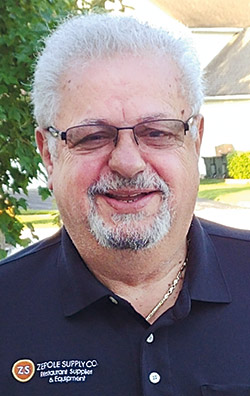The foodservice industry has changed quite a bit since Angelo Parhas worked as a dishwasher, then a busboy, in a Chicago restaurant back in the late ’60s. He moved up the ranks to manager by the time he was 17 years old.
 Angelo ParhasEight years later, Parhas was ready to open his own restaurant in a Chicago suburb. He sold that restaurant five years later to pursue an engineering degree at the University of Illinois-Chicago.
Angelo ParhasEight years later, Parhas was ready to open his own restaurant in a Chicago suburb. He sold that restaurant five years later to pursue an engineering degree at the University of Illinois-Chicago.
After realizing he didn’t want to work in an office environment, Parhas went back to managing restaurants before joining Zepole Supply Co. in 1987. He celebrates his 31st year with the company this month.
Parhas’ expertise includes kitchen and bar design as well as tabletop. His customers are primarily independent restaurants, with some smaller regional chains.
FE&S: How has the industry changed for the better?
AP: Technology has helped change it for the better. We can do more work and not spend time looking for things. There also are more restaurants today. The industry is still changing every year.
FE&S: Before joining the dealership, you spent some time working in restaurants. How has equipment changed?
AP: Cooking equipment hasn’t changed much, other than the appearance and energy efficiency. However, refrigeration has changed tremendously. I do mostly custom equipment, which is not the norm anymore, but my customers appreciate it. Equipment is not equal. There are cheaper options that are not made as well, and efficiency and consistency are compromised. Custom equipment can reduce labor and increase speed of service.
FE&S: What makes a good bar design?
AP: A bar has to look good because it’s in front of customers. It also has to be efficient to sell more drinks. If a bar is not designed efficiently, bartenders and staff need to take more steps to fill an order. This is the difference between selling three drinks in the same amount of time as selling six. Selling three drinks when you could have sold six, that’s lost money.
FE&S: In what ways are bar and kitchen design alike?
AP: The number one way is efficiency. Bars and kitchens are both there to make money and not just look good.
FE&S: What questions do you ask to ensure you specify the right piece of equipment for a particular design?
AP: The kitchen and bar have to be designed around the menu. This will tell me what they’re making and how they’re making it. I also ask how much volume they anticipate. And there’s always a budget, but it’s typically negotiable if equipment can be put to better use in the long run. Operators will sometimes put together a budget without knowing all the factors, and many times it’s unrealistic.
FE&S: You mentor younger salespeople. What’s the most important lesson you want them to learn?
AP: You have to know your product and look out for customer needs. It’s not just about the sale. Anyone can sell something. But if you sell them the wrong item, they won’t come back. Be honest and straight with them.
FE&S: Any advice you’d give someone starting out?
AP: Give yourself time and learn the industry and product. You cannot expect to make it in this business overnight. Also, the personal touch should always be there. This is still a face-to-face business.



